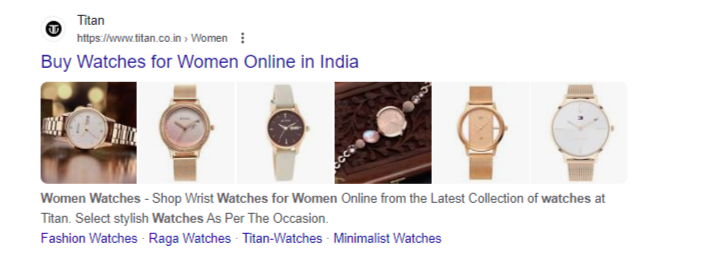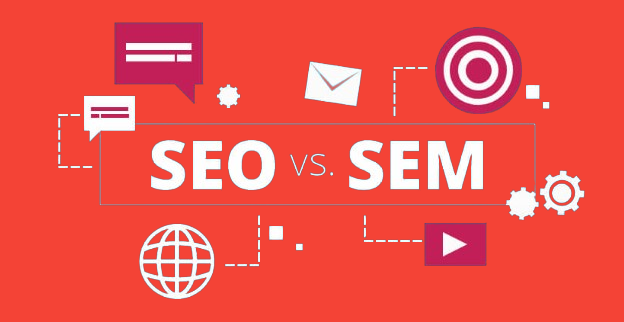Many people often start their online journey by asking search engine questions. In other words, search engines like Google and Bing are most helpful in getting your products or services in front of your potential customers.
In this article, I will discuss the components of Search Engine Marketing (SEM), explore how it works, and delve into the details of SEO.
When you search for something on Google, you will come across two types of results. They are:
Paid Search Results
These results are labeled as “sponsored” or “Ad”. Businesses pay a fee each time someone clicks on their ad. This type of advertising is called Pay-Per-Click (PPC) advertisements.

Organic Search Results
They are unpaid results that appear on a search engine results page (SERP). The results page is displayed because Google search engines consider it relevant and helpful to user’s search queries.

SEO (Search Engine Optimization) deals with what you do to improve organic search results.
SEM ( Search Engine Marketing) deals with both paid and organic search results. It is what you do to drive traffic to your site from search engines. Traffic can be from organic or paid results or both.
SEO is employed to generate traffic from organic search results while Pay-Per-Click (PPC) is employed to get traffic from paid results.
Let’s look into what there is to know about SEO
SEO is done to improve your website rankings in search engines’ organic results. The processes include;
(1) Keyword Research
(2) On-Page SEO
(3) Off-Page SEO
(4) User Interaction Signals
1. Keyword Research
It’s understanding words or phrases your customers type into Google search engines and using these keywords to produce content that will be most helpful to them. This means aligning your content with the searcher’s intent.
2. On-Page SEO
Include things done on your website that will help your visitors have a good experience like well-crafted content, compelling title tags, short and clear meta descriptions, using images or videos where and when necessary, and a good webpage URL.
3. Off-Page SEO
Off-Page SEO are what you do outside of your website to show Google that your website is trustworthy and credible. It involves;
(I) Having quality backlinks to your site from websites with high domain ratings and authority.
(II) Using Google business profiles to attract customers from local searches. Investing in this can increase your visibility for local searches. It also displays your reviews which act like endorsements from the community.

3. Technical SEO
These are things done to make your site faster, easy to crawl, and index by Google search engines. Technical SEO includes site mobile-friendliness and proper site architecture setup.
4. User Interaction Signals
This is all about the way users interact with your site. It includes time retention (how long they stay on your site), and bounce rate ( the rate at which visitors leave your site). It helps google to figure out if your page is a good match or not. If your page is considered a bad fit for a keyword, your site can be dropped.
SEM ( Search Engine Marketing)
Recall, that SEM is made up of organic search results (SEO-related) and paid search results (PPC Ads related).
What’s PPC?
PPC (Pay-Per-Click): This is a form of advertising where you pay Google or other search engine platforms that advertise your website when people click on it.
PPC practice involves;
Keyword Research
This is identifying the keywords relevant to your business that match with your campaign goals.
For example, you own a fashion wear store for ladies in Abuja. You might want your ad to appear when someone in Abuja searches the keywords ” women’s wear”, “women’s clothing/fashion”, or “ladies’ fashion dresses”.
Bidding
In PPC you bid on a specific keyword and when someone searches for that keyword your ad shows up. The rankings of ads are proportional to how much someone is bidding. The highest bidder will appear above all of the ads.
When your ad is clicked, you pay the amount that you bid. The amount that you pay when someone clicks on your ad is known as cost per click (CPC).
For Instance, if you sell fashion wear and set a bid of $1, you are telling the search engine you are willing to pay up to $1 each time someone clicks your ad.
Audience Targeting
This is where you specify certain criteria for who you want your ads to show.
Ad Creation
This is where you decide what your ad needs to communicate to people and it must be effective. It involves crafting a compelling headline, a relevant description, and a clear Call to Action (CTA) like “Click the link below”, “Claim now”, “Subscribe now”, etc.
Quality Score is a Google Ads metric that is an evaluation of your site’s clickthrough rate (CTR), Ad relevance (how your ad matches the searcher’s intent, if it’s a good match for whatever someone is searching for), and the quality of your landing page.
A great Ad copy will result in high CTR and this will naturally have a good Quality Score. It implies that Google will charge you less for the same click.
Tip!
When writing ad copy look at your competitors and learn from their ads.
SEO and SEM: The Cost
Search Engine Optimization (SEO), commonly referred to as “Free website traffic,” can attract a lot of people as clicks are free once you rank. However, ranking takes a considerable amount of time and effort. It’s not as simple as it seems; you need to invest in your website, content production, backlinks, and SEO tools.
Once your website ranks, you don’t need to invest a lot of money into maintaining your current rankings.
SEM approach that involves PPC means paying for each click. You spend money upfront, but you can expect immediate results.
For the short term, PPC generates results faster. Everything ends once when you stop paying and your traffic goes to zero.
For businesses with a limited budget. I recommend you stick to organic tactics which is the use of SEO in the early stages of growth.
For companies that need to start driving more business, paid campaigns generate results faster.
How long does it take to see results?
SEO builds up gradually. It takes months, some years to see a rise in organic rankings and traffic.
PPC is quicker and offers immediate results that can be improved over time.
How to Practice
SEO
For a limited budget
For informational content
For long-term goals
PPC
Short-term goals
Quick Results
For transactional contents
Conclusion
An effective SEM strategy involves utilizing both SEO and PPC to achieve short-term and long-term goals.

